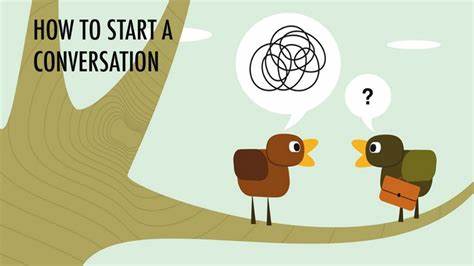Starting a conversation might seem easy, but many people find it challenging. Whether you want to make new friends, network for work, or simply break the ice with strangers, knowing the right way to begin can make all the difference. A good conversation starter opens doors, builds trust, and sets a positive tone for communication. In this blog, we will explore how to start a conversation effectively from different angles — social, professional, and casual — along with practical tips and psychological insights.

Why Starting a Conversation Well Matters
The way you start a conversation can influence its entire course. A friendly and respectful opening can make others feel comfortable and willing to engage. On the other hand, a poor or awkward start might cause discomfort or even shut down communication altogether. According to social psychologist Dr. Nicholas Epley, first impressions set the stage for interaction, so the opening words are crucial in signaling your interest and attitude.
Starting conversations well helps in building relationships, creating opportunities, and reducing social anxiety. It is a vital social skill that impacts both personal and professional life.
Understand Your Environment and Context
Before starting a conversation, consider where you are and who you are speaking to. Different settings require different approaches. For example, starting a chat at a social gathering like a party might be more casual and light-hearted, while at a professional meeting, the tone should be polite and focused.
Understanding context also means respecting cultural norms and personal boundaries. What works in one culture or group might not be suitable in another. Being observant and adaptable is key.
Use Simple and Genuine Openers
The best way to start a conversation is often with something simple and genuine. A smile paired with a friendly “Hello” or “How are you?” is universally welcoming. People respond well to sincerity.
Asking open-ended questions encourages others to share more. Instead of yes/no questions, try something like, “What brought you here today?” or “How do you find this event?” This invites the other person to talk more, which helps the conversation flow naturally.
Psychologist and communication expert Dr. Mark Goulston recommends showing curiosity and empathy in your questions to create a connection.
Use Compliments and Observations
Compliments can be effective icebreakers if they are genuine and respectful. For instance, praising someone’s work, outfit, or even their choice of a book or gadget can start a positive interaction.
Observations about the immediate surroundings or situation can also work well. For example, commenting on the weather, the venue, or something interesting happening nearby can be a neutral way to engage someone.
Practice Active Listening
Starting a conversation is not just about what you say, but also how you listen. Active listening means paying close attention to the other person’s words, showing interest through nods or small verbal affirmations like “I see” or “That’s interesting.”
When you listen actively, you can ask relevant follow-up questions, which keeps the conversation going and makes the other person feel valued.
Avoid Sensitive or Controversial Topics at First
When initiating a conversation, it’s best to steer clear of topics that might cause discomfort or disagreement early on. Politics, religion, or personal finance can be sensitive subjects. Instead, focus on neutral and positive themes until you know the other person better.
Body Language Speaks Volumes
Non-verbal communication plays a huge role in starting a conversation. Smiling, making eye contact, and maintaining an open posture show you are approachable. Avoid crossing your arms or looking away, as these might signal disinterest or defensiveness.
Mirroring the other person’s body language subtly can also help build rapport.
Tailor Your Approach to Different Situations
Starting Conversations with Strangers
When meeting someone new, introduce yourself with a clear and confident voice. Sharing your name first invites reciprocity. For example, “Hi, I’m Sarah. How about you?” works well. Then, use a simple question related to the context.
Starting Conversations at Work
In a professional setting, it’s important to be polite and respectful of time. Start with a greeting and a work-related topic, such as “Did you attend the last meeting?” or “I wanted to get your opinion on the project.”
Starting Conversations with Friends or Family
With people you know, the approach can be more relaxed. Asking about recent events in their life or expressing interest in their hobbies helps deepen bonds.
Overcoming Fear and Social Anxiety
Many people hesitate to start conversations due to fear of rejection or awkwardness. To overcome this, remind yourself that most people appreciate friendly interactions. Practicing conversation starters in low-pressure situations can build confidence.
Techniques like deep breathing before approaching someone and focusing on the other person rather than yourself can reduce anxiety.
The Role of Technology in Starting Conversations
In today’s digital age, starting conversations online or via text messages follows many of the same principles. Begin with a polite greeting and show genuine interest in the person. Avoid jumping into heavy topics or sharing too much personal information immediately.
Apps and social media platforms offer tools like shared interests or mutual friends that can serve as conversation starters.
Conclusion
Starting a conversation the right way is about being genuine, respectful, and attentive. It involves understanding the context, using simple openers, showing interest, and being mindful of non-verbal cues. Whether in social, professional, or casual settings, these skills help build meaningful connections and open doors to new opportunities.
With practice and patience, anyone can become more comfortable and skilled at initiating conversations. Remember, every great relationship begins with a single hello.
SMART Goals to Become a Quality Student in 2024
References
- Epley, N. (2014). Mindwise: How We Understand What Others Think, Believe, Feel, and Want. Vintage.
- Goulston, M. (2013). Just Listen: Discover the Secret to Getting Through to Absolutely Anyone. AMACOM.
- Brown, B. (2015). Daring Greatly: How the Courage to Be Vulnerable Transforms the Way We Live, Love, Parent, and Lead. Gotham Books.
- Mehrabian, A. (1972). Nonverbal Communication. Aldine-Atherton.

